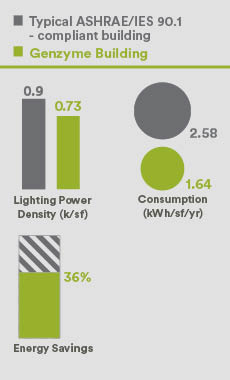
Facts about the building
Project type: New Construction
Building type: Commercial
Location: Cambridge, MA
Project completion: 2005
Project size: 350,000 sf
Occupied during construction? No
Credentials: LEED Platinum certified building
Existing Conditions
Genzyme, a biotechnology company, develops medicines and technologies in the life sciences field. The Genzyme Headquarters opened in 2005 in Cambridge, Massachusetts. Implementing a dependable daylight control system was a complex undertaking due to the region’s frequent and unpredictable precipitation and cloud cover patterns.
Design Conditions
Genzyme’s daylighting system was designed to distribute natural light evenly to the occupants, utilizing daylight technologies for both the internal and exterior windows. 60% of workstations are situated directly adjacent to external windows or windows on the central atrium, and desks are placed at right angles to windows to minimize glare. Exterior windows have a clear double-skin façade that has 20% light transmittance, plus advanced daylight redirecting blinds shaped to bounce light up to a 90% reflective ceiling. The blinds have an inverted mirror finish and are perforated to maintain some outside visibility in all positions. They are controlled automatically but can be temporarily overridden by occupants.The use of glass walls and translucent panels to separate offices and work stations maximized the use of natural light throughout the interior of the workspace. Additionally, a full-height atrium on interior walls provided more “borrowed” natural light from other floors.The lighting system is designed to minimize wasted light, using a mixture of both direct and indirect fixtures to light the office. Occupants have personal dimming controls for individual fixtures located directly above their workspaces. Many luminaries are connected to a photocontrol system that responds to daylight conditions based on a rooftop sensor. The lights are organized into groups to maintain an even distribution of illumination across the ceiling.
Project Team
Lyme Properties
Owner
Rick Mattila
Daylighting at Genzyme
Behnisch, Behnisch & Partner
Daylighting at Genzyme
Next Phase Studios of Jamaica Plain, MA
Daylighting at Genzyme
Bartenbach LichtLabor from Austria
Daylighting at Genzyme
Performance
Workspaces located near exterior windows have enough daylight to light their area without any supplementary lighting about 60% of the time. Perimeter lights are programmed to dim until completely off, depending on the amount of daylight available. While none of the interior workspaces can be lit exclusively with daylight, penetration of daylight to the interior space provides dimmable ballasts with enough natural light to save some energy. As a result, Genzyme’s lighting system is rarely operating at full output during the day. According to a questionnaire conducted in 2011 that surveyed a typical floor in the Genzyme building, about half the occupants are satisfied with the lighting quality in the workspace. However, a common concern is that in some areas, the light is too dim. There were no noise complaints related to the sounds of the motors controlling the automatic shades.
Benefits
• Lighting energy use was reduced by 36% relative to a typical code-compliant building with the same mix of private and open offices.
• Electricity consumption was cut by 45% relative to an identical building constructed without photocontrols.
• A majority of employees have immediate access to natural light.
• 58% of employees believe they are more productive in the new headquarters.
• Genzyme offers tours and interactive kiosks providing information about the eco-friendly features of the building to heighten sustainability awareness.
Lessons Learned
• Start early to optimize savings.
• Genzyme enabled the building’s long-term sustainability from the start by setting up commissioning and maintenance systems and putting together an extensive and accessible operations manual early in the process.
• Daylighting system is successfully working as intended 6 years after implementation.
• Even in environments with extreme daylight variability, advanced daylighting systems can still be successfully utilized.
• Almost half of the occupants found their workspaces too dim. Therefore, lowering partition heights to improve views and adding light fixtures with more “glow” should be explored.
Conclusion
The Genzyme Building saved 45% of its electrical lighting energy by constructing a building with advanced daylighting systems that continue to function properly years after they were first commissioned. Henri A. Termeer, Genzyme’s chairman and chief executive officer, explained his outlook on building the headquarters:“Creating a green building that sets new baselines in sustainability is consistent with what we do every day as a corporation, creating innovative standards of care for patients with untreatable diseases.”Genzyme’s successful implementation of a daylighting system provides a comfortable and sustainable work environment for the employees.
“The photocontrols system has been working extremely well for six years. The only change we would like to make would be to bring more fixtures under photocontrol.